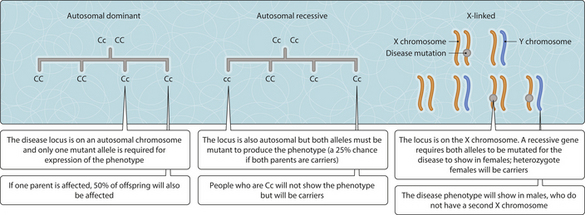Chapter 32 Congenital and inherited diseases
Some inherited syndromes are associated with a specific increased risk of cancer development; these are discussed separately in more detail in Ch. 33.
Diseases with a Mendelian inheritance pattern
Many inherited diseases occur through a mutation within a single gene and with a pattern of inheritance that fits Mendelian genetics. This means that mutations within one or both copies of a gene result in clinical effects with a dominant, codominant or recessive expression pattern (Table 3.32.1 and Fig. 3.32.1). Dominant inheritance means that a mutation within one copy of a gene produces clinical effects when the second gene copy is normal. Recessive inheritance means that mutations are required within both copies of a gene in order that a clinical effect becomes evident. Individuals possessing one recessively inherited mutated gene and one normal gene are termed carriers: that is they may pass the mutation to offspring but do not show clinical evidence of the disease. X-linked disorders are those in which a mutation is present within an X-chromosome, usually in a recessive manner; therefore, the effect of the mutation is masked in females whose second gene copy is normal (these individuals are carriers) but is present in males carrying the mutation since there is no second copy of the gene present within the Y-chromosome.
Table 3.32.1 Examples of genetic diseases
| Inheritance pattern and disease | Key clinical features |
|---|---|
| Autosomal dominant | |
| Huntington’s disease | Progressive neurodegeneration |
| Neurofibromatosis | Multiple neurofibromas |
| Familial adenomatous polyposis | Colonic polyps and early colorectal cancer |
| Polycystic kidney disease | Multiple renal cysts and renal failure |
| Marfan’s syndrome | Tall stature and cardiovascular abnormalities |
| Familial hypercholesterolaemia | Accelerated atherosclerosis |
| Autosomal recessive | |
| Cystic fibrosis | Multisystem including respiratory failure (Ch. 50) |
| Phenylketonuria | Mental retardation |
| Glycogen storage diseases | Hypoglycaemia; organ failure |
| Sickle cell anaemia | Haemolysis and sickle crises |
| X-linked inheritance pattern | |
| Duchenne muscular dystrophy | Progressive muscular failure |
| Haemophilia | Haemorrhage and bruising |
| Fragile X syndromea | Severe mental retardation |
a Approximately 20% of males inheriting the fragile X mutation are phenotypically normal but can act as carriers.
< div class='tao-gold-member'>
Stay updated, free articles. Join our Telegram channel

Full access? Get Clinical Tree







